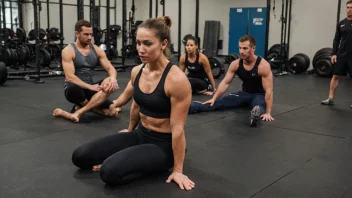Running is a popular and effective form of exercise that offers numerous health benefits, from improved cardiovascular health to enhanced mental well-being. However, many runners overlook the importance of flexibility training, which is essential for maximizing performance and preventing injuries. This article explores how to effectively incorporate flexibility training into your running routine, providing insights into various techniques, exercises, and the science behind flexibility.
Understanding Flexibility and Its Importance for Runners
Flexibility refers to the range of motion available at a joint or group of joints. For runners, having good flexibility is crucial as it can enhance stride efficiency, improve running form, and reduce the risk of injuries such as strains and sprains. A well-structured flexibility training regimen can lead to better overall performance and a more enjoyable running experience.
The Benefits of Flexibility Training
- Improved Range of Motion: Flexibility training allows joints to move through their full range of motion, which is essential for an efficient running stride.
- Enhanced Muscle Performance: Flexible muscles are better able to generate power and resist fatigue, leading to improved running speed and endurance.
- Reduced Injury Risk: Flexibility can help prevent injuries by ensuring that muscles and connective tissues can adapt to the stresses of running.
- Better Posture and Alignment: Incorporating flexibility exercises can improve posture, leading to better alignment during running and reducing the risk of biomechanical issues.
- Faster Recovery: Flexibility training aids in recovery by promoting blood flow and reducing muscle soreness after runs.
Types of Flexibility Training
There are several approaches to flexibility training, each with its own methods and benefits. Runners can choose the one that best fits their training style and goals.
Static Stretching
Static stretching involves holding a stretch for a prolonged period, typically between 15 to 60 seconds. This type of stretching is best performed after a run when muscles are warm. Examples of static stretches for runners include:
- Hamstring Stretch
- Quadriceps Stretch
- Calf Stretch
- Hip Flexor Stretch
- Lower Back Stretch
Dynamic Stretching
Dynamic stretching involves movement-based stretches that improve flexibility while also warming up the muscles. This type of stretching is ideal before a run. Examples include:
- Leg Swings
- Walking Lunges
- High Knees
- Butt Kicks
- Arm Circles
PNF Stretching (Proprioceptive Neuromuscular Facilitation)
PNF stretching is a more advanced technique that combines stretching and contracting of the muscle group being targeted. It typically requires a partner and is excellent for increasing flexibility. The common method involves:
- Stretching the muscle to the point of mild discomfort.
- Contracting the muscle against resistance for about 5-10 seconds.
- Relaxing the muscle and then stretching it further.
How to Create a Flexibility Training Routine
Incorporating flexibility training into your running routine requires thoughtful planning and consistency. Here’s a step-by-step guide to help you develop an effective routine:
Assess Your Current Flexibility
Before starting a flexibility training program, assess your current flexibility levels. This can be done through self-assessment tests, such as the sit-and-reach test or by observing how far you can reach during various stretches.
Set Flexibility Goals
Define specific flexibility goals based on your assessment. For example, you might aim to improve your hamstring flexibility or increase your hip mobility. Setting measurable goals will help track your progress.
Develop a Schedule
Incorporate flexibility exercises into your weekly running schedule. Aim for at least two to three sessions per week, dedicating 10-20 minutes per session. Consider the following:
- Pre-Run: Include dynamic stretches to warm up your muscles.
- Post-Run: Focus on static stretching to promote recovery and flexibility.
- Dedicated Flexibility Sessions: Consider adding additional sessions focused solely on flexibility training.
Incorporate Variety
To keep your routine engaging and effective, include a variety of stretches and techniques. This variety can help target different muscle groups and prevent boredom.
Track Your Progress
Keep a journal or use a mobile app to track your flexibility progress. Note any improvements or challenges you face, and adjust your routine as necessary.
Common Flexibility Exercises for Runners
This section highlights several effective flexibility exercises that runners can integrate into their routines:
1. Standing Quadriceps Stretch
This stretch helps improve flexibility in the quads, an essential muscle group for runners. Stand on one leg, pull your other foot towards your glutes, and hold for 15-30 seconds.
2. Seated Hamstring Stretch
While seated, extend one leg out and reach towards your toes, feeling the stretch in your hamstring. Hold for 15-30 seconds, then switch legs.
3. Hip Flexor Stretch
From a kneeling position, push your hips forward while keeping your torso upright to stretch the hip flexors. Hold for 15-30 seconds and switch sides.
4. Butterfly Stretch
Sitting with the soles of your feet together, gently press your knees towards the ground to stretch the inner thighs. Hold for 15-30 seconds.
5. Downward Dog
This yoga pose stretches multiple muscle groups, including the calves, hamstrings, and shoulders. Hold for 15-30 seconds while focusing on your breathing.
Incorporating Technology into Flexibility Training
Advancements in technology can enhance your flexibility training experience. Various apps and devices provide guided stretches, track progress, and offer personalized flexibility plans. Consider using:
- Fitness Apps: Many apps offer customizable stretching routines and track your progress over time.
- Wearable Devices: Some fitness trackers can provide insights into your muscle recovery and flexibility levels.
- Online Video Resources: Platforms like YouTube host numerous stretching tutorials led by certified trainers.
Conclusion
Incorporating flexibility training into your running routine is essential for enhancing performance and reducing the risk of injuries. By understanding the importance of flexibility, utilizing various training methods, and creating a structured routine, runners can experience significant benefits. Remember to assess your current flexibility, set achievable goals, and track your progress to ensure long-term success. With dedication and consistency, flexibility training can lead to improved running efficiency and overall athletic performance.






